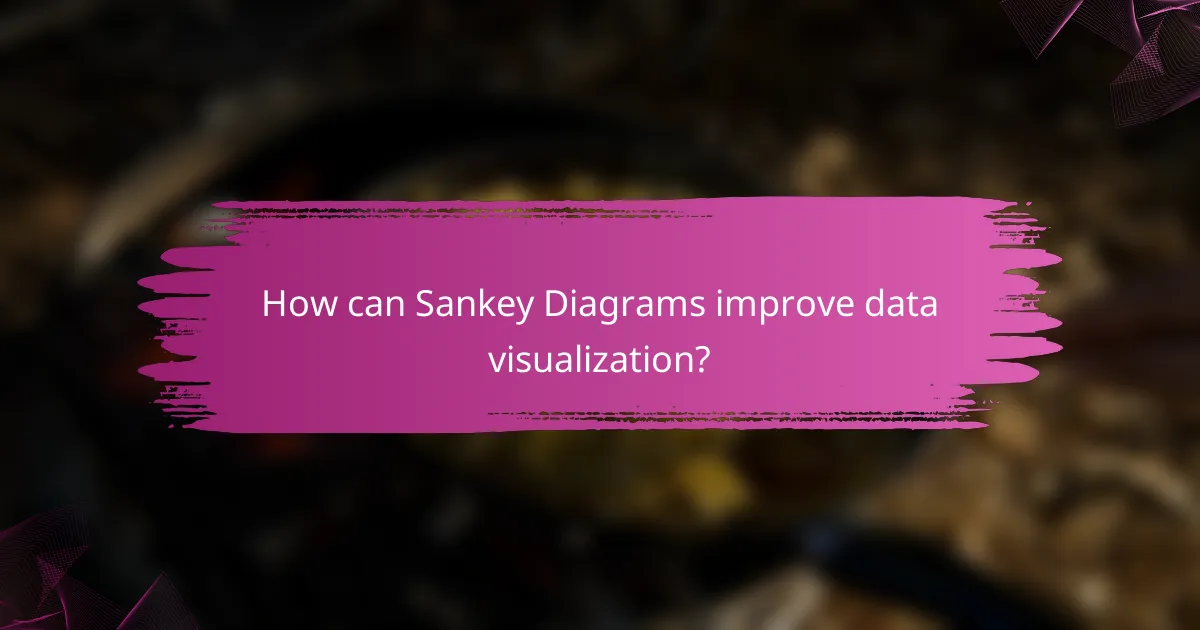Sankey Diagrams are powerful tools for visualizing the flow of resources, energy, or information, using proportional arrows to represent quantities. By simplifying complex data movements, they help identify patterns and relationships, making it easier to grasp intricate information at a glance. These diagrams are particularly useful in fields such as energy transfer and data analytics, where clarity of flow is essential.

How can Sankey Diagrams improve data visualization?
Sankey Diagrams enhance data visualization by clearly illustrating the flow of resources, energy, or information. They provide a visual representation that simplifies complex data movements, making it easier to identify patterns and relationships.
Enhanced clarity of data flow
Sankey Diagrams improve clarity by using proportional arrows to represent the magnitude of flows. This visual format allows viewers to quickly grasp how data moves from one point to another, highlighting both the sources and destinations of resources.
For example, in a financial context, a Sankey Diagram can show the flow of funds between different departments, making it easy to see which areas consume the most resources. This clarity helps stakeholders understand where to allocate budgets effectively.
Effective energy transfer representation
In energy management, Sankey Diagrams are particularly useful for visualizing energy transfer and consumption. They can depict how energy is generated, distributed, and utilized across various sectors, providing insights into efficiency and waste.
For instance, a Sankey Diagram might illustrate the flow of electricity from power plants to residential areas, showing losses during transmission. This representation aids in identifying opportunities for reducing energy waste and improving overall efficiency.
Improved decision-making insights
By visualizing data flows, Sankey Diagrams facilitate better decision-making. They allow decision-makers to see the big picture and understand the implications of their choices on resource allocation and efficiency.
For example, a company analyzing its supply chain can use a Sankey Diagram to identify bottlenecks or inefficiencies in product movement. This insight can lead to more informed strategies for optimizing operations and reducing costs.

What are the best tools for creating Sankey Diagrams?
Some of the best tools for creating Sankey diagrams include Tableau, Google Charts, and Microsoft Power BI. Each of these platforms offers unique features that cater to different needs, such as interactivity, web integration, and business analytics.
Tableau for interactive visualizations
Tableau is a powerful tool for creating interactive Sankey diagrams that allow users to explore data visually. Its drag-and-drop interface makes it easy to connect various data sources and customize the flow representation.
One of the key advantages of Tableau is its ability to handle large datasets efficiently. Users can create dynamic visualizations that update in real-time, providing immediate insights into data movement and energy transfer.
Google Charts for web-based solutions
Google Charts is an excellent choice for those looking to embed Sankey diagrams directly into web applications. This free tool offers a simple API that allows for quick integration and customization of visualizations.
With Google Charts, users can create responsive diagrams that adjust to different screen sizes. It supports various data formats and is particularly useful for developers who want to enhance user experience with interactive features.
Microsoft Power BI for business analytics
Microsoft Power BI is ideal for businesses seeking to analyze and visualize data flows through Sankey diagrams. It integrates seamlessly with other Microsoft products, making it a convenient option for organizations already using the Microsoft ecosystem.
Power BI offers advanced analytics capabilities, allowing users to drill down into data and uncover trends. Its user-friendly interface and robust features make it suitable for both technical and non-technical users, ensuring that insights are accessible to all stakeholders.

How do Sankey Diagrams work?
Sankey diagrams visualize the flow of data, energy, or materials through proportional arrows, where the width of each arrow represents the quantity being transferred. They effectively illustrate relationships and movement, making complex data sets easier to understand at a glance.
Flow representation through proportional arrows
In a Sankey diagram, flows are depicted using arrows whose widths are proportional to the magnitude of the flow they represent. For example, if one flow is twice as large as another, its arrow will be twice as wide. This visual representation allows viewers to quickly grasp the relative sizes of different flows and identify major contributors to the overall system.
To enhance clarity, colors can be used to differentiate between various types of flows or categories. This helps in quickly associating specific flows with their sources or destinations, making the diagram more intuitive.
Data input requirements and setup
Creating a Sankey diagram requires a clear dataset that outlines the sources, targets, and values of the flows. Typically, this data is structured in a table format, with columns representing the source, target, and flow value. For instance, a simple dataset might include energy inputs from various sources and their corresponding outputs to different sectors.
When setting up the diagram, ensure that the total input values match the total output values to maintain balance. Common pitfalls include using inconsistent units or failing to account for all flows, which can lead to misleading visualizations. A good practice is to validate your data before finalizing the diagram to ensure accuracy and coherence.

What are the applications of Sankey Diagrams in energy transfer?
Sankey diagrams are effective tools for visualizing energy transfer, illustrating how energy moves through systems. They help identify sources, losses, and efficiencies in energy flows, making them valuable in various applications, especially in renewable energy and industrial settings.
Visualizing renewable energy flows
Sankey diagrams play a crucial role in visualizing renewable energy flows by clearly depicting the contributions of different energy sources such as solar, wind, and hydro. For instance, a diagram can show how much energy is generated from each source and how it is distributed across consumption sectors like residential, commercial, and industrial.
When creating these diagrams, consider using distinct colors for each energy source to enhance clarity. This visual differentiation helps stakeholders quickly grasp the overall energy landscape, facilitating better decision-making regarding energy investments and policy development.
Tracking energy consumption in industries
In industrial settings, Sankey diagrams are used to track energy consumption across various processes and departments. By mapping out energy inputs and outputs, companies can identify areas of inefficiency and potential savings. For example, a manufacturing plant might use a Sankey diagram to illustrate energy use in production lines versus administrative functions.
To maximize the effectiveness of these diagrams, ensure that they are updated regularly to reflect changes in energy use patterns. This practice allows organizations to monitor progress towards energy efficiency goals and make informed adjustments to their operations.

What are the benefits of using Sankey Diagrams in e-commerce?
Sankey Diagrams provide a visual representation of data flows, making them particularly beneficial in e-commerce for understanding customer behavior and optimizing sales processes. They illustrate the movement of users through various stages of the purchasing journey, allowing businesses to identify bottlenecks and opportunities for improvement.
Understanding customer journey flows
Sankey Diagrams help visualize the customer journey by mapping out the paths users take from initial contact to final purchase. This clarity allows e-commerce businesses to see where customers drop off or get stuck, which can inform strategies to enhance user experience.
For example, if a significant number of users abandon their carts after viewing shipping options, businesses can investigate and potentially revise their shipping policies or improve the checkout interface. Tracking these flows over time can reveal trends and shifts in customer behavior.
Analyzing sales conversion paths
By utilizing Sankey Diagrams, e-commerce companies can analyze the conversion paths that lead to sales, highlighting which channels are most effective. This analysis is crucial for allocating marketing resources efficiently and maximizing return on investment.
For instance, if a diagram shows that social media campaigns lead to higher conversions compared to email marketing, businesses can shift focus and budget toward social platforms. Regularly reviewing these paths can help refine strategies and improve overall sales performance.

What criteria should be considered when choosing a Sankey Diagram tool?
When selecting a Sankey Diagram tool, consider factors such as ease of use, integration capabilities, and the specific features that meet your data visualization needs. A good tool should allow for clear representation of data flow and energy transfer while being user-friendly.
Ease of use and user interface
The user interface of a Sankey Diagram tool should be intuitive, allowing users to create diagrams with minimal effort. Look for drag-and-drop functionality and customizable templates that simplify the design process. A tool that offers tutorials or help resources can also enhance usability.
Consider tools that provide real-time feedback as you build your diagram. This feature helps ensure that the data is accurately represented and allows for quick adjustments, which is particularly useful when working with complex datasets.
Integration capabilities with existing data
Integration with existing data sources is crucial for effective Sankey Diagram creation. Choose a tool that can easily connect to databases, spreadsheets, or APIs to streamline the data import process. This capability saves time and reduces the risk of errors during data entry.
Additionally, check if the tool supports various data formats, such as CSV or JSON, to ensure compatibility with your current systems. A flexible integration approach allows for more dynamic and up-to-date visualizations, enhancing the overall effectiveness of your data representation.
